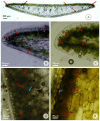Influence of Sucrose and Activated Charcoal on Phytochemistry and Vegetative Growth in Zephyranthes irwiniana (Ravenna) Nic. García (Amaryllidaceae)
- PMID: 38475416
- PMCID: PMC10935178
- DOI: 10.3390/plants13050569
Influence of Sucrose and Activated Charcoal on Phytochemistry and Vegetative Growth in Zephyranthes irwiniana (Ravenna) Nic. García (Amaryllidaceae)
Abstract
Zephyranthes irwiniana (Ravenna) Nic. García is an endemic, red list threatened species from the Brazilian savanna (Cerrado) with pharmacological potential to treat the symptoms of Alzheimer's Disease (AD). This work analyzed the vegetative growth and phytochemistry of its potential compounds, in response to variations in sucrose concentration and activated carbon (AC). Seeds were germinated in vitro and in the greenhouse. The in vitro bulbs were separated in six treatments with different sucrose concentrations (30, 45 and 60 gL-1) and/or AC (1 gL-1). Biomass increases in individuals grown in the greenhouse were higher than those cultivated in vitro. Sucrose concentration significantly increased biomass and root number. AC had a positive influence on leaf and root size, and a negative influence on root number. GC-MS analyses indicated great variation in the abundance of α-terpenyl-acetate, ethyl linoleate, clionasterol and lycorine between treatments, with maximum concentrations of 53.06%, 38.68, 14.34% and 2.57%, respectively. Histolocalization tests indicated the presence of alkaloids in the leaf chlorenchyma and bulb cataphylls. Finally, the present study provided new evidence that the constitution of the culture medium directly influences the vegetative growth and phytochemistry of this species, providing a good medium condition for propagating the species under threat.
Keywords: activated charcoal; histolocalization test; lycorine; phytochemistry; sucrose; vegetative growth.
Conflict of interest statement
The authors declare no conflict of interest. The funders had no role in the design of the study; in the collection, analysis, or interpretation of data; in the writing of the manuscript; or in the decision to publish the results.
Figures





Similar articles
-
Tissue-Specific Natural Synthesis of Galanthaminein Zephyranthes Species and Its Accumulation in Different In Vitro-Grown Organs Following Methyl Jasmonate Treatment.Plants (Basel). 2024 Jul 13;13(14):1931. doi: 10.3390/plants13141931. Plants (Basel). 2024. PMID: 39065458 Free PMC article.
-
Screening of Amaryllidaceae alkaloids in bulbs and tissue cultures of Narcissus papyraceus and four varieties of N. tazetta.J Pharm Biomed Anal. 2019 Aug 5;172:230-237. doi: 10.1016/j.jpba.2019.04.043. Epub 2019 Apr 24. J Pharm Biomed Anal. 2019. PMID: 31060036
-
Carbohydrates stimulated Amaryllidaceae alkaloids biosynthesis in Leucojum aestivum L. plants cultured in RITA® bioreactor.PeerJ. 2020 Mar 16;8:e8688. doi: 10.7717/peerj.8688. eCollection 2020. PeerJ. 2020. PMID: 32211230 Free PMC article.
-
The Genus Nerine Herb. (Amaryllidaceae): Ethnobotany, Phytochemistry, and Biological Activity.Molecules. 2019 Nov 21;24(23):4238. doi: 10.3390/molecules24234238. Molecules. 2019. PMID: 31766438 Free PMC article. Review.
-
The Phytochemistry and Pharmacology of Tulbaghia, Allium, Crinum and Cyrtanthus: 'Talented' Taxa from the Amaryllidaceae.Molecules. 2022 Jul 13;27(14):4475. doi: 10.3390/molecules27144475. Molecules. 2022. PMID: 35889346 Free PMC article. Review.
References
-
- Huang C.W., Okubo H., Uemoto S. Comparison of bulblet formation from twin scales and single scales in Hippeastrum hybridum cultured in vitro. Sci. Hortic. 1990;42:151–160. doi: 10.1016/0304-4238(90)90156-9. - DOI
-
- Rahimi Khonakdari M., Rezadoost H., Heydari R., Mirjalili M.H. Effect of photoperiod and plant growth regulators on in vitro mass bulblet proliferation of Narcissus tazzeta L. (Amaryllidaceae), a potential source of galantamine. Plant Cell Tissue Organ Cult. 2020;142:187–199. doi: 10.1007/s11240-020-01853-y. - DOI - PMC - PubMed
-
- Us-Camas R., Rivera-Solís G., Duarte-Aké F., De-la-Peña C. In vitro culture: An epigenetic challenge for plants. Plant Cell Tissue Organ Cult. 2014;118:187–201. doi: 10.1007/s11240-014-0482-8. - DOI
-
- Zaragoza-Puchol D., Ortiz J.E., Orden A.A., Sanchez M., Palermo J., Tapia A., Bastida J., Feresin G.E. Alkaloids analysis of Habranthus cardenasianus (Amaryllidaceae), anti-cholinesterase activity and biomass production by propagation strategies. Molecules. 2021;26:192–209. doi: 10.3390/molecules26010192. - DOI - PMC - PubMed
Grants and funding
LinkOut - more resources
Full Text Sources
Miscellaneous

